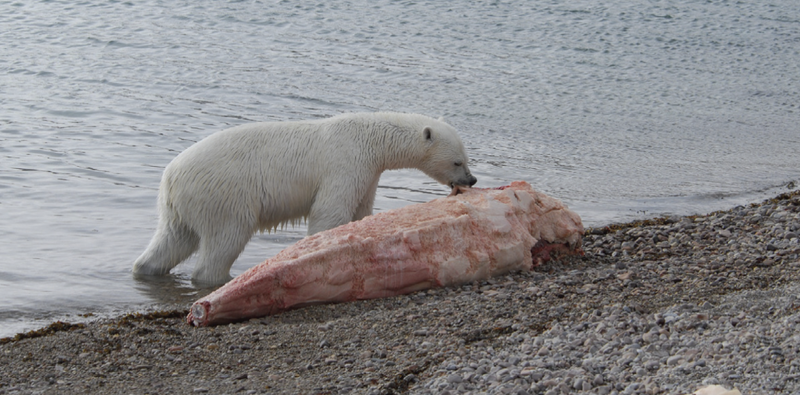Interactions
Narwhals are predatory animals. They feed on fish like
Atlantic Cod, cephalopods,
and crustaceans. The main predators of narwhals are human beings
(Reeves & Tracey 1980). Humans used to hunt narwhals for meat
and blubber as a source of food and fuel, and their skin and
ivory for various other things (Marcoux 2008).
Killer whales
have been known to drive away narwhals if they get to close, but
have not been seen actually hunting and killing narwhals. Sharks
and
polar bears will sometimes attack narwhals trapped at ice
holes or feed on ones that have died there (Reeves & Tracey
1980).
Narwhals rely on ice holes because narwhals, like most
aquatic mammals, have a blowhole and need to surface to breathe.
This becomes a problem if the narwhals spend too much time in the
Arctic Circle before returning south and the water begins to freeze
over (Palsbøll et al. 1996). If narwhals become trapped
by the ice, they often find themselves having to rely on small
openings in the ice to respire. This is called savssats (Palsbøll
et al. 1996; Reeves & Tracey 1980). Unfortunately, this makes them
easy prey for polar bears and sharks as mentioned before.
Additionally, this entrapment also causes many to die of either
exhaustion or starvation, giving sharks and other predators in the
area a free meal (Reeves & Tracey 1980).
Narwhals are greatly affected by human shipping traffic.
Ships traveling through the water create significant amounts of
noise that affects the behavior of narwhals. These noises can affect
narwhal travelling direction, the way they surface to breathe, and
how they interact with other pods (Marcoux 2008). This noise
pollution is particularly damaging when narwhals are hunting for
food because they rely on sounds to locate prey. It has also been
noted that helicopters flying above narwhals can affect their
behavior due to the force of the helicopter on the water (Reeves &
Tracey 1980).
Noise interference from ships or helicopters can also
interfere with narwhal communication. Narwhals communicate via two
different types of vocalizations. One type is pulsed sounds which,
as seen in other marine animals, are thought to be used for
echolocation. This would help guide the narwhals as they swim as
well as help them locate prey. The second type of vocalization is a
mix of whistles and burst-pulsed sounds. These are believed to be
used for communication with other narwhals (Marcoux 2008).
